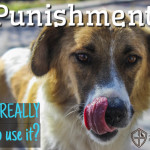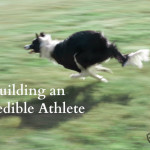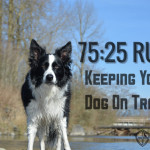Are You Listening?
Communication between dog and handler is important
Our dogs are communicating with us every single day, but are we listening? We’re talking to our dogs every day, but are they listening?
Through my years of working one on one with clients, and having my own dogs at home, I can tell you that humans ignore their dogs’ communication too much. I believe that from the moment we bring our dogs home, it is our responsibility to take the time to understand them; there are two sides to a relationship and both sides need to be happy in order to succeed.
What Are They Saying?
Dogs communicate differently - there is no doubt about that. However, through domestication and time we tend to anthropomorphize our dogs, projecting human behaviour onto them– sometimes we’re correct, but sometimes we’re way off. So how do we learn to better communicate with our dogs?
Watch and Learn – a wonderful way to learn about canine behaviour is to literally sit and watch dogs interact with each other. Each behaviour they do is purposeful as each small movement of their facial muscles or tail means something. Oftentimes, owners don’t even know they are correctly understanding their dog, so they second guess their assumption based on wrong information given to them by searching the internet or from an “experienced dog owner/professional”.
Facial Expressions

Just by looking at your dog you will be able to tell their emotions as if you were looking at a human. You can see if they are showing appeasement, irritation, joy, sorrow, etc. This will be a bit harder to tell with certain breeds who have excessive hair on their face or droopy skin. However, most of the time owners will be able to tell what mood their dog is in -- how happy they are, if they are irritated or if they’re tired -- simply by living with the dog and watching.
Body Language
This is the biggest, most noticeable language that dogs have to communicate with other dogs, people and other species. Dogs use their whole body - head placement, paws, torso, tail - to indicate a signal/behaviour because they are very limited in their vocalizations.
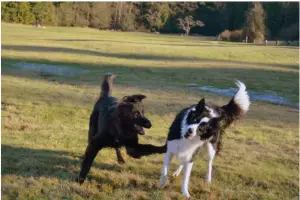
Head placement – whether a dog’s head is held high, mid or low will tell a lot about how that dog is wanting to be perceived or how they are feeling about a situation. Generally, a head held high will mean confidence or high arousal, a head held at mid height (in line with their shoulders) will indicate a dog that is calm, confident, neutral and if the head is held low, it will indicate the dog is not confident, non-threatening, inquisitive/curious.
Paws – if you look closely, you can tell if your dog is on his or her tippy toes. This will mean that your dog has a high arousal mental state. If a dog lifts their paw, this can indicate stress or anxiety about a situation, but it can also mean in many work breeds “pointing” to the prey – so situations must be taken into account to decipher why the paw is up. And a shaking paw can mean high arousal or anxiety, and can often be paired with a trembling torso.
Tail – Wagging tails can be broken into a few different communication signals. When we’re looking at tail wags, we always look at the BASE of the tail (where the tail meets the body), not the tip of the tail. If the base of the tail is almost pointing at the sky, this means high arousal. Now, depending on which way it is wagging will tell you a lot; if it is dominantly wagging to the dog’s right side of the body, this means positive (good feelings), if the tail is wagging dominantly to the dog’s left side of the body, this means negative (bad feelings). And if the tail is wagging in what we call a rainbow (all the way to the left and right) this can be generalized as very happy and then there is the helicopter (going in circles) means exuberantly happy. The north and south direction of the tail is just arousal, the lower the tail the lower the arousal levels in the dog, for the most part. There are a few cases where you will see a very anxious dog tucking their tail in anticipation (very common with herding breeds); they’re happy but very anxious about the situation, anxious in anticipation.
Torso – This is the bulk of the dog, from shoulders to hip and often overlooked because the signs can be very subtle. Tension can be shown when the dog’s body goes rigid; this dog is incredibly stiff and will not move a muscle on the torso, even though the tail may be wagging and head busy sniffing. When a dog goes rigid/stiff, it usually means this is a very tense situation between dog and dog, or dog and human. Often, after you see this, you will see a “shake off” to shake off the tension they were feeling. Many dogs will often burst into a play bow to break the tension, and it usually works. Piloerection is when the hackles on your dog's back stand up. This is often referred to as goosebumps, and dogs that are very excited will show this , as well as dogs that are very fearful. Just because the hackles are up, does not mean anything bad, you’ll often see this when a dog is over-aroused in conjunction with other over-arousal behaviours.
The Good & the Bad
Most of us are very good at figuring out when our dog is happy, but the majority of dog owners are oblivious when their dog is becoming upset. How many times do you hear “the dog attacked the other dog completely out of the blue”? This is often assessed very incorrectly, and not because of ill knowledge but because a lack thereof.
Rarely ever is a dog fight or dog attack ‘out of the blue’. There are often many signals that we failed to recognise before the bomb exploded. Dogs indicate stress well before any bad behaviours happen; these are called “stress signals”, often called displacement or calming signals too. These signals are given by a dog to communicate that they are feeling negative emotions and often wanting to tell the other party that.
Common stress signals include:
- Lip lick (tongue covering nose or licking just the front of the snout)
- Yawning
- Head turn or looking away from the stimuli
- Sniffing randomly
- Scratching randomly
- Head ducking
- Tail tucking
- Paw lift
These behaviours can be seen alone or in conjunction with one or more other signals. It is completely situational, depending on what is going on in the situation. Lip licking is usually one of the most obvious and common amongst canines, and is often shown first before any other stress signals follow. When a dog is showing one or more of these behaviours to another dog and they are being ignored, or perhaps both parties are being unknowingly forced into a situation together, stress can increase and the possibility of aggressive behaviours can be exhibited- it just depends on the dog’s personality and level of tolerance. Stress creates aggression in dogs, just like it does with humans; the more stress you are exposed to, the lower your tolerance is.
Stress signals can also be shown in happy dogs, otherwise known as good stress. Dogs that are incredibly excited will often lip lick and yawn (calming themselves down) and even have been known to show paw lifting behaviour.
When trying to decipher what your dog is feeling, you must take into account the situation that your dog is in and apply accordingly.
What Are We Saying?
Honestly, we take verbal communication for granted with our dogs. We‘re talking to them all day long, telling them what to do and what not to do, but are we being clear? When you give them a cue, are you acknowledging their success or are you assuming they know?
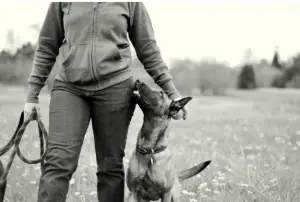
Feedback is important for any relationship; you need to know what you’re doing right and what you’re doing wrong. Often, dog owners have no problem telling their dogs what they’re constantly doing wrong, but fail to recognize what they’re doing right. Dogs are living in a world surrounded by another species with a completely different communication system; they often do what they feel like doing, just because.
Good behaviour is expected, but rarely rewarded. Exceptional behaviour is often rewarded, but it’s not often shown. Bad behaviour is constantly being recognized and verbally corrected, but how often does your dog learn from it if they are continually repeating it?
Dogs that are constantly being corrected and scolded will often become either indifferent to you or have low self-esteem and stressed. Dogs don’t like to do things wrong, especially herding breeds, they have been bred to work very closely with the handlers and they love to please you!
Start recognizing all the good your dog does by letting your dog know with a simple “good dog!”. You don’t have to get fancy and break out amazing treats every time, but for exceptional behaviour you may want to think about unzipping that Ziploc bag. If your dog is lying down calmly, let them know you like that! You’d be surprised at how quickly your dog will offer the behaviour more often. At the same time, when your dog is doing something that we don’t necessarily appreciate, let them know nicely “uh, no, let’s not do that” in a neutral tone that expresses displeasure. No need to get loud or intense with the dog. Once the dog has stopped the bad behaviour, recognize that and let them know you liked the fact that they stopped doing the bad behaviour “good dog! That’s more like it!” I bet you will get a tail wag and a look of joy from your dog.
By increasing our feedback to our dog, we tell them that we are paying attention to them and we do care what they do. If you ignore your dog all the time, the dog thinks you don’t care!
If you’re interested in more information on Canine Body Language, I encourage you to watch my video’s that have descriptions of canine body language so you can see it firsthand.
Understanding Dog Body Language Part 1
Understanding Dog Body Language Part 2
Article By:
Kris Crestejo
Meet Our Evangelist



